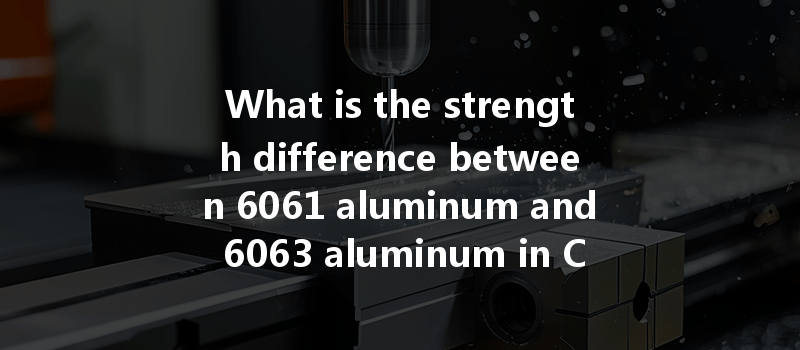Did you know that aluminum is the most widely used non-ferrous metal in the world today? The global aluminum production reached over 60 million metric tons in 2023, with applications ranging from aircraft to automotive components. Among the various aluminum alloys available, 6061 and 6063 are two of the most popular choices for CNC machining, particularly for turning processes. But how do their strengths compare, and what does that mean for their applications?
This guide will explore the key differences in strength between 6061 aluminum and 6063 aluminum in the context of CNC turning. We’ll delve deeply into mechanical properties, applications, machining considerations, and more, providing a comprehensive overview of the strengths and weaknesses of these two alloys.
1.1 What are Aluminum Alloys?
Aluminum alloys are mixtures of aluminum with other elements like copper, manganese, silicon, magnesium, and others. These alloys are designed to enhance certain properties, including strength, corrosion resistance, and workability, making them suitable for specific applications.
1.2 The 6000 Series
Alloy series classification in aluminum helps identify the predominant alloying elements. The 6000 series is primarily based on magnesium and silicon. It is known for excellent corrosion resistance, good weldability, and medium to high strength.
1.3 Understanding 6061 and 6063
Both 6061 and 6063 aluminum alloys belong to the 6000 series, but they have distinct properties because of their unique alloying compositions.
The strength of an aluminum alloy is a fundamental characteristic that determines its suitability for various applications. Here we explore several important properties in detail.
2.1 Tensile Strength
Tensile strength is a material’s resistance to being pulled apart. For 6061 aluminum, the tensile strength typically ranges from 20,000 to 42,000 psi, depending on the temper. In comparison, 6063 aluminum showcases a lower tensile strength, usually falling between 18,000 to 27,000 psi.

Implication: If an application demands higher tensile strength, 6061 would be the more suitable choice.
2.2 Yield Strength
The yield strength is the amount of stress at which a material begins to deform plastically. For 6061, the yield strength can be as high as 35,000 psi, while 6063 typically has a yield strength around 16,000 psi for the same tempers.
Implication: Higher yield strength in 6061 means it can handle greater loads without permanent deformation, making it more reliable in structurally demanding applications.
2.3 Elongation & Ductility
Ductility refers to the ability of a material to deform under stress. 6061 aluminum has an elongation percentage of about 12-18%, while 6063 can elongate between 8-12%.
Implication: While 6061 offers better ductility, 6063 is favored for its ease in shaping and forming, especially in architectural applications.
2.4 Fatigue Strength
Fatigue strength indicates how well a material can withstand repeated loading. 6061 typically exhibits better fatigue strength, which means it can endure cyclical stress without failure.
Implication: For dynamic applications, such as in transport or machinery, 6061 would generally be preferred due to its superior fatigue resistance.
3.1 Machinability Considerations
When it comes to CNC machining, machinability might differ between 6061 and
3.2 CNC Turning Skills and Techniques
In CNC turning, the skills and techniques employed can significantly impact outcomes. Here are some recommendations to consider when machining these alloys:
3.3 Tooling and Feed Rates
The choice of tooling, including the type and material of cutting tools, affects the efficiency of the turning process. Using carbide tools is often recommended for CNC turning 6061 and 6063 because of their hardness and wear resistance.
4.1 Industry-specific Uses
4.2 Case Studies
5.1 Material Selection
Choosing the right material based on the application’s requirements is crucial. Consider factors such as stress loads, environmental exposure, and fabrication methods when opting for either alloy.
5.2 Process Optimization
Streamlining CNC machining processes enhances efficiency and productivity. Use advanced machining strategies like adaptive machining that adjusts tool path based on real-time data feedback.
5.3 Quality Control Measures
Implement meticulous quality control throughout the machining process. Regular inspections, both visual and dimensional, ensure that parts meet specified tolerances and surface finishes.
In summary, understanding the strength differences between 6061 and 6063 aluminum is integral for making informed decisions in CNC machining applications. While 6061 is noted for its superior tensile and yield strength, 6063 excels in architectural applications due to its exceptional extrudability and surface finish.
Choosing between these two alloys hinges on specific application demands, from structural integrity to aesthetic considerations. As industries continue to evolve, these insights guide engineers and fabricators towards materials that enhance performance while satisfying modern demands.
In an era where precision and quality matter more than ever, taking the time to understand material properties will undoubtedly pay off in terms of performance, cost-efficiency, and product longevity. Remember, when choosing your materials for CNC turning, think carefully about the needs of your project—6061 and 6063 both have their unique strengths, and leveraging them to your advantage can lead to outstanding results.






